DJI’s transforming quadcopter is out in the wild. I got to fly this futuristic-looking aircraft for a few minutes. The Inspire 1 looks good, it’s packed with features, including a few novel ones, but it also comes with more than a few “warning” labels! I met André Verville in a gymnasium a the Cégep de Limoilou college, in Québec. It was -22°C (-8°F) outside, so indoor flying was the only option. Verville is the president of Photo-Métrique, a company that specializes in land surveying. He was flying his brand new Inspire 1 for the first time, having done the mandatory firmware update and calibrations the day before. Verville has designed his own multirotor, the Observer-6, which he also sells. He provides UAV training courses for land surveyors and predicts that many of them will want to use the new DJI aircraft. “Right now, the Inspire 1 is not ready for that job,” says Verville. “It’s missing the waypoint flight planning and the picture time lapse on the camera need to be faster than 5 seconds. But we know those features are coming.”
The Inspire 1 has a special set of sensors on its belly (2 sonars and an optical camera), pointing downwards, that allow it to “see” the ground. Even indoors, without GPS, it should be able to remain stationary on its own. Unfortunately, the first thing we noticed after liftoff was that the Inspire 1 did not hold its position on the XY plane. The camera may have been fooled by the glossy gymnasium floor … Or it may have been some other issue. DJI is still working out the bugs. Regardless, it needed continuous pilot correction.
On the positive side, I found that the gain settings were very good right out of the box. Motion was smooth but not sluggish, which is what I want in a good flying camera. It’s not a racing quad, but felt plenty fast. And even when banking sharply, I always felt in complete control. There was no over-correcting. The yaw movement was especially pleasant. When I sent the Inspire 1 into a full spin, it recovered almost as soon as I let go of the sticks, without even the slightest change in altitude.
This feat is most likely possible due to the sonar, which worked flawlessly and kept the aircraft at a constant altitude without pilot input, a definite attribute for shooting video close to the ground. But it doesn’t work everywhere. Verville had done some cold tests over carpet and had discovered that the distance-measuring sonar doesn’t like that kind of surface. So location can have a strong impact on the performance of that feature. We also had a few compass errors during our 20 minute test. It may have been due to the gymnasium’s metal structure…
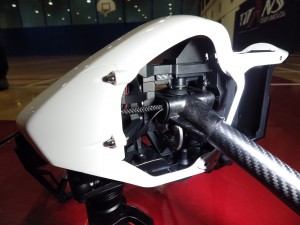
The transforming arms/landing gear combo keeps weight at a minimum. However, Verville and I are both concerned about having to repair this intricate system of gears if ever it breaks.
The distinguishing characteristic of the Inspire 1, if you haven’t seen it yet, is the transforming arms/landing gear. It’s neat! It keeps weight at a minimum, gives the camera a 360 degree field of view, and lowers the quad’s center of gravity to increase stability. However, Verville and I are both concerned about having to repair that intricate system of gears if ever it breaks.
As with any retractable landing gear, the camera is going to suffer if you ever come down too fast with the legs up. Thanks to its sensors, the Inspire 1 will lower its arms automatically if it’s less than about three feet from the ground, but the transformation takes several seconds. You can’t increase that distance in the settings, for the moment, something Verville wishes he could do to protect the camera in the event of an emergency landing.
The camera and 3-axis brushless gimbal are both part of a unified component called the Zenmuse X3 that comes off easily for storage or replacement. Stabilization was flawless, but we only tested it indoors. The camera records video in ultra high definition and the sample images we took where very good, considering the gymnasium’s poor lighting. Unfortunately, it will only do full 4K video at 24/25 fps. If you want 30 fps, you will have to make do with a resolution of 3840 x 2160. For comparison, the GoPro Hero4 Black does the full 4K30p.
On the other hand, the X3 doesn’t have a fisheye lens, so the image is not distorted like it usually is on a GoPro. The lens also has a filter ring, making it easy to use a polarized filter. Otherwise, you can use the clear protective filter that comes with the kit.
The handheld radio is smaller than your average Futaba, but felt comfortable and natural to hold. As with everything DJI, however, you won’t be able to tune it like you would your average radio. For instance, we couldn’t find any way of adjusting the trim. The use of a smartphone or tablet is also mandatory to access most of the settings and options.
The Inspire 1 comes equipped with the Lightbridge system, which means that the remote also receives telemetry and video. But to access this data, you need to connect an iOS* or Android device with a USB cable. Fair warning: although most devices will work, not all of them have enough processing power to show the video feed.
Verville tested it with an Android GalaxyTab 2, an iPad Mini (1st generation) and an iPhone 5C, but they all suffered from excessive lag. He had better results with his Samsung Galaxy Tab 2. Even if you bought your device recently, there’s no guaranty that it’ll work properly, unless it’s on DJI’s list of supported devices. “People using a large screen tablet may find it cumbersome”, says Verville. “A small tablet like mine is pretty much ideal.”
The Inspire 1 comes with only one 6S 4500 mAh battery. It’s good for an average of 15 minutes of flying, and takes about an hour and a half to recharge. It’s a “smart” battery with built-in cell monitoring, and is made specifically for the Inspire 1. It also has its own built-in charger, so it just needs to be connected to the power adapter. Same goes for the remote: just plug the power adapter and it charges itself.
But those fancy batteries are expensive! The 4500 mAh is sold at $160, and you’ll have to cough up $200 for the 5700 mAh. “I have a client who crashed his drone because he didn’t strap the battery well enough and it fell”, recalls Verville. “This can’t happen with this device. It’s a plus, function-wise, but a minus price-wise.”
Propellers are 13 inches, 4.5 pitch, self-tightening. They are made of a plastic and carbon-fiber composite. There’s a risk a propeller could come off during a sudden motor deceleration and DJI is now giving Inspire 1 users free propeller locks and recommending that they use them.
What attracts me most about the Inspire 1 is the fact that it’s a full system, ready to fly out of the box. Every component has been optimized to work with everything else. Hobbyists will hate not having room to tinker or fix their setup, but that comes down to the age-old PC vs Mac, open vs closed system, rivalry. Some will love it, others will hate it, with little room in between.
“It’s going to be something easy for beginners to pick up and fly”, says Verville. “But given the price point, it might not be the right choice for beginners anyways. But it’s a very easy machine to pilot.”
The Inspire 1 is also very easy to deploy. It takes only a few minutes from the moment you take it out of its carrying case to the moment it’s up in the air, a plus for drone journalism or disaster response. However, Verville dislikes having to turn on both the radio and the Inspire 1 to move the arms from their horizontal “storage” position down to their “ready” position. You have to do this every time you take it out, and do the reverse when you put it back in its suitcase. It feels like an unnecessary step, one that you should be able to carry out manually, without the help of the radio.
The Inspire 1 can also do a few neat tricks, like auto take-off and landing, but we were hesitant to try it indoors, especially with the position-holding feature misbehaving like it did. That was probably a good decision, because a YouTube video has already surfaced showing an Inspire 1 crashing catastrophically during an automatic take-off.
Overall, the Inspire 1 is a marvelous machine. Even those who dislike the DJI brand have to admit that, considering all the Phantoms sold, DJI is the undisputed champion of marketing multirotors to the masses. The Inspire 1 is yet another example of this. That being said, it still feels like DJI is working out the kinks. To be fair, the aircraft that we tested was pre-ordered, and that always comes with a disclaimer. But unless you can’t help yourself and must have the newest, shiniest toys, I would recommend holding off on this purchase until DJI gives it a final polish. In fact, the name itself is a reminder that there will surely be an Inspire 2 in the not too distant future.
The Good
- Complete system in one sleek, compact, aircraft.
- Ergonomic and practical design.
- Lots of easily accessible features and settings.
- Professional-looking (subjective).
- Relatively long flight time (+20 minutes with 5700 mAh battery).
- Ground sensors for indoor altitude and position hold.
- Integrated 3-axis gimbal with 4K video camera.
- GPS inside the remote may enable “follow-me” feature in the future.
The Bad
- Still feels like DJI is working out the bugs with firmware updates.
- Waypoint navigation not yet implemented.
- Commitment to exclusively purchase DJI parts and accessories.
- Expensive batteries.
- No motor or battery redundancies.
- Ground sensor performance varies depending on surface.
- Potentially expensive and complicated repairs after an accident.
- No interface for PC.
- Tablet computer or smartphone required and sold separately.
Pricey extras
The DJI Inspire 1 starts at $2,900, or $3,400 for the dual remote version. But here’s what else you might end up having to buy for a functional kit:
- • $200 or $160 for every extra battery.
- • $55 for an extra power adapter if you want to recharge more than one battery at a time.
- • $300 to 800 for a new tablet or smartphone.
- • $400 for the custom travel case.
Total: $4000 to $5000.
The Inspire 1 supports the following devices, according to DJI:
iOS*
- iPhone 5s, 6 or 6 Plus
- iPad Air 1 or 2
- iPad mini 2 or 3
- iPad 4
Android
- Samsung S4, S5
- Samsung Galaxy Note 3 or Note Pro (P900)
- Sony Z3 EXPERIA
- Google Nexus 7 II
- Mi 3
- Nubia Z7 mini
Quick Specs
- All-up weight: about 3 kg
- Dimensions: 438 x 451 x 301 mm
- Max speed: 80 kph
- Max wind speed resistance: 36 kph
- Max flight time: 15-18 minutes with 4500 mAh battery; 20-22 minutes with 5700 mAh battery
- Battery type: LiPo 6S
- Operating temperature range: -10° to 40°C
- Video camera resolutions: UHD (4K): 4096x2160p24/25, 3840x2160p24/25/30
FHD: 1920x1080p24/25/30/48/50/60 - Camera sensor: Sony EXMOR 1/2.3″
- Mobile Device System Requirements: iOS version 7.1 or later*; Android version 4.1.2 or later.
[IMPORTANT]
*As of January 16th, DJI has removed any mention of iOS support from its website. According to customer support, DJI is currently awaiting approval of it’s app by Apple, so this information may change in the future. If you plan on using an Apple device with your Inspire 1, I recommend waiting for the app to make it to the Apple App Store, just to be on the safe side.
Text & photos by William Levasseur


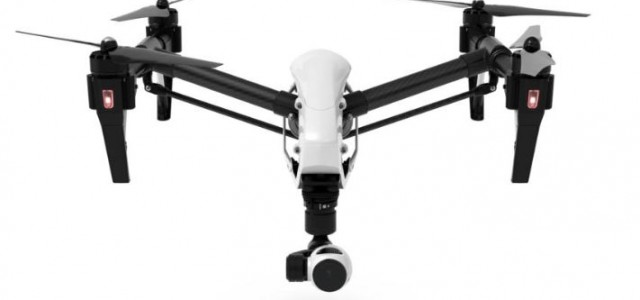
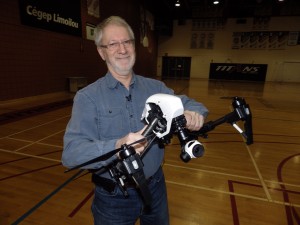
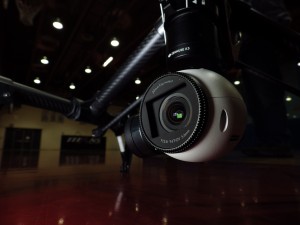
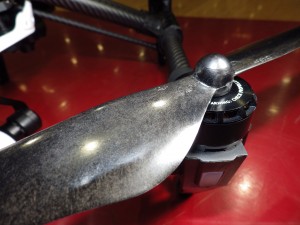


















A brilliant, impartial and very informational review. Enjoyed reading it several times over
Now this is something I really need to get my hands on (if only it wasn’t so expensive). I have used my friends smaller toy drone before (he only paid about $80 for it and it didn’t really do anything and crashed frequently, but it was fun) and that’s it. I have wanted to own a professional one for taking images from the air, and this would be perfect for someone like me. For the price though, I could use that money to put a down payment on a car or something. I was reading about it the other day on my phone’s news app. PN had an interview with them when they reviewed it. Made me want to reach through the screen and steal it from them lol (ref: http://pocinc.net/blog/technology-news/the-new-dji-inpire-1-quadcopter-drone-review-with-interview/ ). I hope it comes down in price a little. Either that or one of the other ones they wrote about. I remember reading about another one they covered that could fly itself without any controller (that was cool).